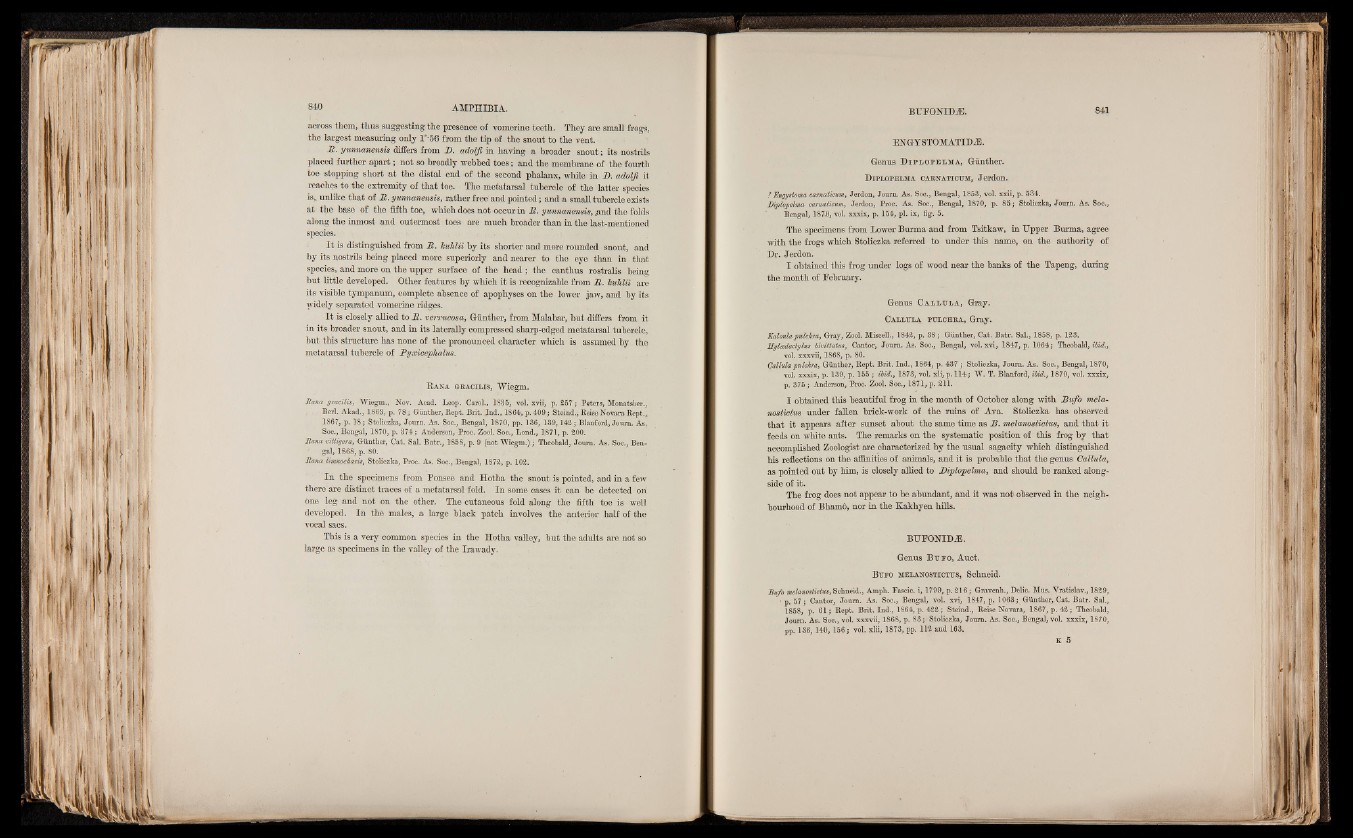
across them, thus suggesting the presence of vomerine teeth. They are small frogs,
the largest measuring only l"-56 from the tip of the snout to the vent.
22. yunnanensis differs from D. aclolji in having a broader snout; its nostrils
placed further apart; not so broadly webbed toes; and the membrane of the fourth
toe stopping short at the distal end of the second phalanx, while in D. adolfi it
reaches to the extremity of that toe. The metatarsal tubercle of the latter species
is,, unlike that of 22. yimnanensis, rather free and pointed; and a small tubercle exists
at the base of the fifth toe, which does not occur in 22. yimnanensis, .and the folds
along the inmost and outermost toes are much broader than in the last-mentioned
species.
I t is distinguished from JR. Icuhlii by its shorter and more rounded snout, and
by its nostrils being placed more superiorly and nearer to the eye than in that
species, and more on the upper surface of the head ; the canthus rostralis being
but little developed. Other features by which it is recognizable from 22. Icuhlii are
its visible tympanum, complete absence of apophyses on the lower jaw, and by its
widely separated vomerine ridges.
I t is closely allied to 22. verrucosa, Gunther, from Malabar, but differs from it
in its broader snout, and in its laterally compressed sharp-edged metatarsal tubercle,
but this structure has none of the pronounced character which is assumed by the
metatarsal tubercle of Pyxicephalus.
B a n a g r a c il i s , Wiegm.
Bana gracilis, Wiegm., Nov. Acad. Leop. Carol., 1885, vol.' xvii, p. 257; Peters, Monatsber.,
Berl. Akad., 1863, p. 78.; Gunther, Kept. Brit. Ind., 1864, p. 40.9; Steind., ReiseNovara Rept.,
1867, p. 18.; Stoliczka, Journ. As. Soc., Bengal, 1870, pp. 186, 139, 142; Blanford, Joum. As.
Soc., Bengal, 1870, p. 374; Anderson,-Proc. Zool. Soc., Lond., 1871, p. 200.
Bana vittigera, Gunther, Cat. Sal. Batr., 1858, p. 9 (hot Wiegm.); Theobald, Joum. As. Soc., Bengal,
1868, p. 80.
Bana limnocharis, Stoliczka, Proc. As. Soc., Bengal, 1872, p. 102.
In the specimens from Ponsee and Hotha the snout is pointed, and in a few
there are distinct traces of a metatarsal fold. In some cases it can be detected on
one leg and not on the other. The cutaneous fold along the fifth toe is well
developed. In the males, a large black patch involves the anterior half of the
vocal sacs.
This is a very common species in the Hotha valley, but the adults are not so
large as specimens in the valley of the Irawady.
EN GT STOMATIDjE.
Genus D i p l o p e l m a , Gunther.
D i p l o p e l m a c a r n a t ic u m , Jerdon.
? Engystoma carnaticum, Jerdon, Journ. As. Soc., Bengal, 1858, vol. xxii, p. 584.
Biplopebna carnaticum, Jerdon, Proc. As. Soc., Bengal, 1870, p. 85; Stoliczka, Journ. As. Soc.,
Bengal, 1879, vol. xxxix, p. 154, pi. ix, fig. 5.
The specimens from Lower Burma and from Tsitkaw, in Upper Burma, agree
with the frogs which Stoliczka referred to under this name, on the authority of
Dr. Jerdon.
I obtained this frog under logs of wood near the banks of the Tapeng, during
the month of Eebruary.
Genus C a l l t j l a , Gray.
Ca l l u l a p u l c h r a , Gray.
Kaloula pulchra, Gray, Zool. Miscell., 1842, p. 38 ; Gimther, Cat. Batr. Sal., 1858, p. 128.
Hyloedactylus bivittatus, Cantor, Joum. As. Soc., Bengal, vol. xvi, 1847, p. 1064; Theobald, ibid.,
vol. xxxvii, 1868, p. 86.
a pulchra, Giinther, Rept. Brit. Ind., 1864, p. 437 ; Stoliczka, Joum. As. Soc., Bengal, 1870,
vol. xxxix, p. 139, p. 155 ; ibid., 1878, vol. xli, p. 114; W. T. Blanford, ibid., 1870, vol. xxxix,
p. 375 ; Anderson, Proc. Zool. Soc., 1871, p. 211.
I obtained this beautiful frog in the month of October along with Bufo mela-
under fallen brick-work of the ruins of Ava. Stoliczka has observed
that it appears after sunset about the same time as 2?. melanostictus, and that it
feeds on white ants. The remarks on the systematic position of this frog by that
accomplished Zoologist are characterized by the usual sagacity which distinguished
his reflections on the affinities of animals, and it is probable that the genus Callula,
as pointed out by him, is closely allied to Diplopelma, and should be ranked alongside
of it.
The frog does not appear to be abundant, and it was not observed in the neighbourhood
of Bhamô, nor in the Kakhyen hills.
BUEONIDJD.
Genus Büro, Auct.
Büro m e l a n o s t ic t u s , Schneid.
Bufo melanostictus, Schneid., Amph. Fascic. i, 1799, p. 216; Gravenh., Delic. Mus. Vratislav., 1829,
* p. 57; Cantor, Jöiim. As. Soc., Bengal, vol. xvi, 1847, p. 1063; Günther, Cat. Batr. Sah,
1858, p. 61; Rept. Brit. Ind., 1864, p. 422; Steind., Reise Novara, 1867, p. 42; Theobald,
Joum. As. Soc., vol. xxxvii, 1868, p. 88 ; Stoliczka, Joum. As. Soc., Bengal, vol. xxxix, 1870,
pp, 186, 140, 156; vol. xlii, 1878, pp. 112 and 168.
K 5